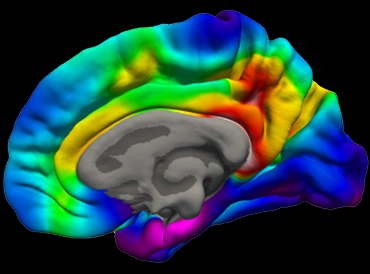| Currently researching brain networks... | ▼ |
"If the brain were so simple we could understand it, we would be so simple we couldn't." –Lyall Watson
To truly comprehend how our brains are working may be too complex a task for any human, but similarly complex is the movement of leaves in a tree when the wind blows through it. Because the brain forms a complex network of over 130.000.000.000 interconnected neurons, there is an opportunity to model it with a limited number of simpler processes.
The graph below shows the network of neurons of a worm of only 1mm in length: the C. elegans (Watts & Strogatz, Nature 1998). Ideally one would also like to construct a human brain model as a collection of a few types of neurons. However in order to capture the full scope of a human brain improved imaging techniques are needed. In the mean time diffusion weighted magnetic resonance imaging techniques make it possible to model the brain on a coarser scale.
At the moment my research focuses on modeling the brain on a macroscopic scale to gain new understanding of its large scale organization. I received my Ph.D. at the MIRA Institute for Biomedical Technology of the University of Twente while conducting research at the Donders Institute in Nijmegen, the Netherlands. Currently I work at the University Hospital Basel, Switzerland.
| The human connectome | ▼ |
"The whole is more than the sum of its parts." –Aristotle
The term human connectome describes the connectivity matrix of the human brain. It has been coined by an influential PLoS computational biology paper by Sporns et al. in 2005. Since then several papers have modeled the human connectome on different scales with different connectivity modalities.
One of my research focus was to make a detailed topographic map of hubs, key areas in the brain which are believed to play an important role in the information flow of the brain. Together with my supervisors David Norris and Anne-Marie van Cappellen van Walsum I have completed this research and it is now published at PLOS ONE. Below you can see one of our main results: a hub map for the medial part of the right hemisphere.

| Brain Subnetworks | ▼ |
"The more I see, the less I know for sure." –John Lennon
Looking at the connections of the whole connectome can be daunting. But even zooming into a subnetwork of the brain disappoints quickly with more complexity. In the back I visualized one of those subnetworks... more will follow.:)
| Family & Meditation | ▼ |
"The amount of happiness that you have depends on the amount of freedom you have in your heart."-Thich Nhat Hanh
I am very fortunate that I have a wonderful support system at home with my loving wife and son. As my research is focused on analyzing connections I sometimes look at the world as a network interconnected entities: one big family. With the rising of the world wide web humans all over the world have become closer and closer to one another. Sometimes this causes more frictions than we are able to deal with in a civilized way, but also in real families harmony is not always given. And while people get to know each other better despite being separate by thousands of kilometers and are overloaded with conflicting information, it becomes increasingly more difficult to find refuge for mental peace.
Inevitably it sometimes can be a real challenge to maintain well connected with one self and with others. Meditation helps me to maintain a balanced perspective and I am happy that my family have this view in common. If you interested in meditation you might want to look at my wifes mindfulness initiative: Hello Mindfulness.
| The Game of Go | ▼ |
"Measure what is measurable, and make measurable what is not so."
–Galileo
It is common approach in game theory that once we can determine the value of items which are at stake we can find optimal solutions for actors competing for those items. Chess is a classic game where game theory was able to help computers to play the game efficiently as the value of a position could easily approximated by considering the value of the pieces.
In Go there is no easy way to determine how much a move is exactly worth as the value of a move is determined through the complex interaction of all stones. Humans are however very good at estimating the value of moves in the game. As an expert Go player I am very fascinated on how we could transfer expert knowledge to a Go playing computer program and I have written my master thesis on this topic.
Photo by Donar Reiskoffer
| Get in touch... | ▼ |
Postal address:
Department of Epidemiology and Public Health
Swiss TPH
Kreuzstrasse 2
CH-4112 Allschwil
Switzerland
e-mail: emil.nijhuis <@>at<@> gmail.com
@mendeley: www.mendeley.com/profiles/emil-nijhuis/